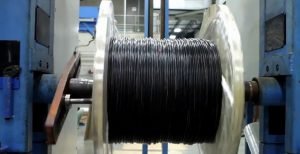 When wire and cable is irradiated by electron beam, the electrons crosslink the jacket, improving performance characteristics – such as higher tensile strength, chemical resistance, abrasion resistance, and improved thermal resistance at elevated temperatures – without changing the dimensional properties.
When wire and cable is irradiated by electron beam, the electrons crosslink the jacket, improving performance characteristics – such as higher tensile strength, chemical resistance, abrasion resistance, and improved thermal resistance at elevated temperatures – without changing the dimensional properties.
How does it differ from chemical crosslinking?
Unlike thermochemical crosslinking methods, e-beam does not limit jacketing materials, minimum wall thickness, nor line speed. The finished product also doesn’t contain any peroxide byproducts or other unreacted residuals, as will chemical crosslinking methods.
What are some everyday applications?
Some everyday industry applications include automotive, aircraft, communications, marine cable, hookup wire and welding cable.
What jacket polymers are suitable for e-beam crosslinking?
The e-beam crosslinking process is suitable for jacketing material made of PVC, ETFE, PVDF, polyolefin, HDPE, EPDM, CPE, Hypalon, EVA, neoprene rubber, polyamide, ethylene-propylene rubber, and others.
How do I learn more?
Reach out to us at ebeam@ebeamservices.com or schedule a call to learn how e-beam can help your product!



